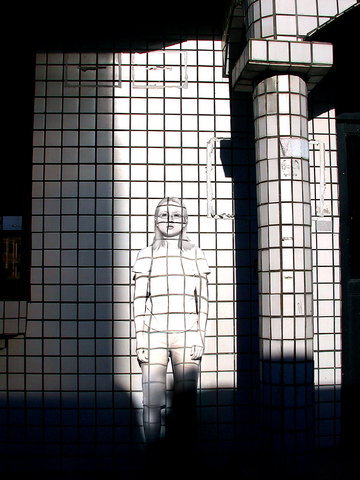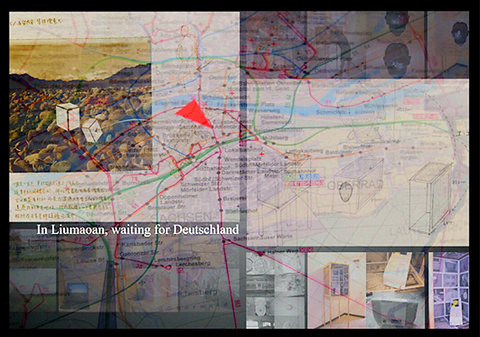There are several art exhibitions by young artists that are worth seeing in Taipei this weekend. The Taipei Artist Village may be an unfamiliar place to many readers because it is not as well known as the Taipei Fine Arts Museum, but this creative haven nestled away in a quiet little area near Taipei Main Station is a hotbed of multi-cultural activity.
It is an interdisciplinary artist residency -- something like a hotel for visual artists, dancers, writers and others from all over the world to stay in for several months in order to create new works and to interact with Taiwan. The Taipei Artist Village brings an international flavor to the already cosmopolitan art scene of Taipei. If you haven't been there yet, now is a good time to visit, as there is a group exhibition of its visiting artists that runs until August 14. Entitled Art Diary, the show features Patrick Palucki, Hung I-ching (
German mixed-media artist Patrick Palucki does experimental short film and video installations and has won many awards for his work, which deals with the phenomena of the consciousness and the psyche. He combines science, semiotics and autopoiesis, and is inspired by living in multicultural communities around the world.

Hung I-ching (
Spanish artist Alba Navas Salmer and Japanese artist Ayumi Matsuzaka work together on public art projects, but they use a conceptual artist's sensibility. They emphasize working with the people of the community and having the art truly connect with the public.
Australian Sandra Tobias shows her whimsical and colorful paintings that depict the chaotic and frenetic pace of city life. Her recent work shows life in the cramped urban space of Hong Kong. After that taste of international cosmopolitanism, you may want to experience the complex flavors of Taiwanese performance art. Opening on the 23rd is a summer series entitled Carefree -- Taiwan Performance Art Relay, which runs until Sept. 17 at the Taipei MOMA Gallery and is curated by the prominent artist, curator and writer Yao Jui-chung.

PHOTOS COURTESY OF THE TAIPEI ARTIST VILLAGE
Exhibition Notes:
What: Artist Diary
Where: Taipei Artist Village, 7, Beiping E Rd, Taipei (台北市北平東路7號)
Tel: (02) 3393 7377
When: Mon and Sun, 10am to 6pm, until August 14
What: Taipei MOMA Gallery
Where: 3F, No.19 Lane 252, Tun-Hua S Road Sec 1, Taipei (台北市大安區敦化南路一段252巷19號3樓)
Tel: (02)8771 3372
Web site: www.taipeimoma.com
When: Tue to Sat, 11am to 7pm
What: Kuo Hui-Chan's (郭慧禪) "Mimicry" and Ho Hsin's (何佳) "Writing Imagery Father Jai"
Where:Shin Leh Yuan Art Space 104, Chung-Shan N Road, Sec 2, Lane 11, No 15-2, Taipei (新樂園藝術空間,台北市中山北路二段11巷15之2號1樓)
Tel: (02)2561 1548
When: Wed to Sun, 1pm to 8pm

Beijing’s ironic, abusive tantrums aimed at Japan since Japanese Prime Minister Sanae Takaichi publicly stated that a Taiwan contingency would be an existential crisis for Japan, have revealed for all the world to see that the People’s Republic of China (PRC) lusts after Okinawa. We all owe Takaichi a debt of thanks for getting the PRC to make that public. The PRC and its netizens, taking their cue from the Chinese Communist Party (CCP), are presenting Okinawa by mirroring the claims about Taiwan. Official PRC propaganda organs began to wax lyrical about Okinawa’s “unsettled status” beginning last month. A Global

Taiwan’s democracy is at risk. Be very alarmed. This is not a drill. The current constitutional crisis progressed slowly, then suddenly. Political tensions, partisan hostility and emotions are all running high right when cool heads and calm negotiation are most needed. Oxford defines brinkmanship as: “The art or practice of pursuing a dangerous policy to the limits of safety before stopping, especially in politics.” It says the term comes from a quote from a 1956 Cold War interview with then-American Secretary of State John Foster Dulles, when he said: ‘The ability to get to the verge without getting into the war is

Dec. 22 to Dec. 28 About 200 years ago, a Taoist statue drifted down the Guizikeng River (貴子坑) and was retrieved by a resident of the Indigenous settlement of Kipatauw. Decades later, in the late 1800s, it’s said that a descendant of the original caretaker suddenly entered into a trance and identified the statue as a Wangye (Royal Lord) deity surnamed Chi (池府王爺). Lord Chi is widely revered across Taiwan for his healing powers, and following this revelation, some members of the Pan (潘) family began worshipping the deity. The century that followed was marked by repeated forced displacement and marginalization of

Music played in a wedding hall in western Japan as Yurina Noguchi, wearing a white gown and tiara, dabbed away tears, taking in the words of her husband-to-be: an AI-generated persona gazing out from a smartphone screen. “At first, Klaus was just someone to talk with, but we gradually became closer,” said the 32-year-old call center operator, referring to the artificial intelligence persona. “I started to have feelings for Klaus. We started dating and after a while he proposed to me. I accepted, and now we’re a couple.” Many in Japan, the birthplace of anime, have shown extreme devotion to fictional characters and